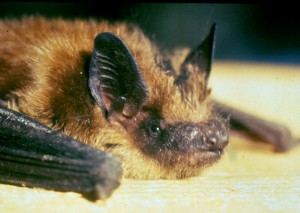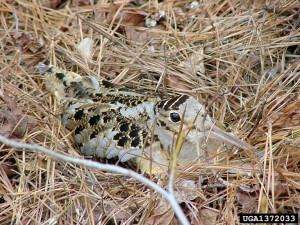 Purdue University - Extension - Forestry and Natural Resources
Purdue University - Extension - Forestry and Natural Resources
Got Nature? Blog
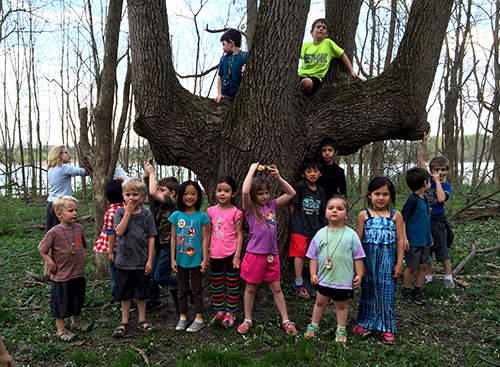 Children today spend an average of 20 minutes outside. Since the dawn of television, video games, and other indoor activities, children are spending more and more of their time indoors and missing out on the many benefits of interacting with nature. Various studies have shown that engaging with nature improves concentration, coordination, creativity, and more. Hands of the Future, Inc. is a nonprofit organization started to educate children about the beauty of nature and help them connect with it.
Children today spend an average of 20 minutes outside. Since the dawn of television, video games, and other indoor activities, children are spending more and more of their time indoors and missing out on the many benefits of interacting with nature. Various studies have shown that engaging with nature improves concentration, coordination, creativity, and more. Hands of the Future, Inc. is a nonprofit organization started to educate children about the beauty of nature and help them connect with it.
Hands of the Future, Inc. has several programs for kids to get involved with. The Junior Nature Club is a free after school program for children in pre-kindergarten through the eighth grade that meets every three weeks to learn about nature through games, crafts, and other activities. The Living Schoolyard Program is a partnership with Indiana schools bringing bits of nature to schools in the forms of “outdoor classrooms” like butterfly gardens and raised bed veggie gardens. A Children’s Forest is even being discussed as Hands of the Future, Inc. becomes more and more successful.
For summer fun sign up for Hands of the Future program! Registration is free.
Volunteers & Interns:
Older students and adults can apply to be a volunteer. Volunteers are always appreciated, no past experience necessary. If you love nature and kids you will enjoy this program. Internships are available for college students, contact Zonda Bryant.
This month’s Junior Nature Club theme is soil, and is taking place on June 21st for pre-kindergarteners to second graders, June 23rd for third to fifth graders, and June 28th for sixth to eighth graders at the Lilly Nature Center at Celery Bog. Look forward to upcoming themes including “Monarch Madness” and “Floating on Air!”
For more information, please check out the Hands of Future, Inc. and Junior Nature Club websites listed below.
Resources:
Hands of the Future, Inc.
Junior Nature Club
How to Register – Hands of the Future, Inc.
PK-12 Programs – Purdue FNR Extension
The Nature of Teaching – Purdue FNR Extension
Zonda Bryant, Director
765.366.9126
director@hands-future.org
Purdue Extension Contact:
Rebecca Busse, Extension Associate
Purdue Department of Forestry and Natural Resources
busser@purdue.edu
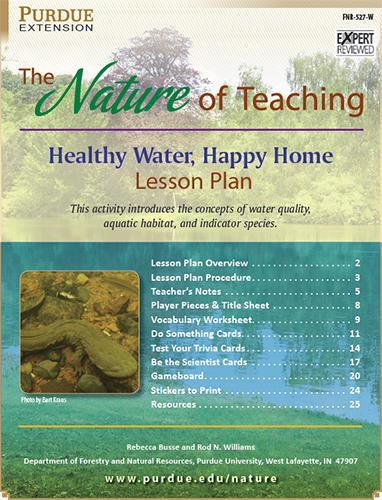 Many choices we make in our daily lives can have an impact on the water quality of rivers and streams around us. Animals like the eastern hellbender need clean water for their habitats, and they depend on us to make environmentally friendly choices whenever possible. Small changes to our daily routines such as sweeping sidewalks and driveways instead of hosing them off can improve water quality around us.
Many choices we make in our daily lives can have an impact on the water quality of rivers and streams around us. Animals like the eastern hellbender need clean water for their habitats, and they depend on us to make environmentally friendly choices whenever possible. Small changes to our daily routines such as sweeping sidewalks and driveways instead of hosing them off can improve water quality around us.
The new lesson plan from The Nature of Teaching titled Healthy Water, Happy Home offers a fun way for 4th and 5th grade students to learn about healthy water choices they can make in their home and community, along with learning how to identify aquatic animal species like the eastern hellbender. Healthy Water, Happy Home is available as a free download in The Education Store which includes a board game, vocabulary worksheet, accompanying lesson notes and power point slides for the teacher. It can be used as a 60-90 interactive classroom lesson on water quality. The board game allows students to choose an aquatic species like the northern water snake or water strider as their player piece, travel along the riverbed answering questions along with completing fun and educational tasks about positive water quality choices. The first group to make it to the hellbender, indicating the highest level of water quality, wins the game.
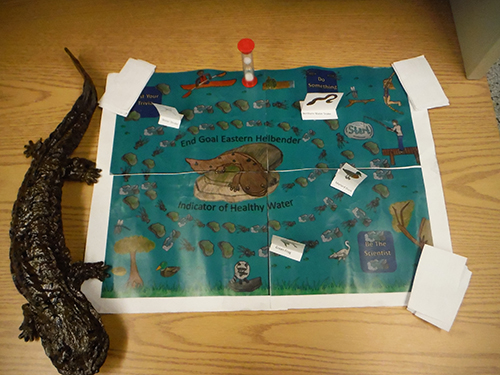 Teachers are highly encouraged to check out Healthy Water, Happy Home as well as the rest of The Nature of Teaching lesson plans for educational wildlife activities for the classroom. To keep updated on resources involving the eastern hellbender conservation efforts, please visit HelpTheHellbender.org.
Teachers are highly encouraged to check out Healthy Water, Happy Home as well as the rest of The Nature of Teaching lesson plans for educational wildlife activities for the classroom. To keep updated on resources involving the eastern hellbender conservation efforts, please visit HelpTheHellbender.org.
Resources:
Healthy Water, Happy Home – Lesson Plan – The Education Store, Purdue Extension Resource Center
The Nature of Teaching – Purdue Extension
Lesson Plans – Help the Hellbender
Kids Resources – Help the Hellbender
Hellbender Havoc video game – Help the Hellbender
Rebecca Busse, Extension Associate
Purdue Department of Forestry and Natural Resources
Rod Williams, Associate Professor of Wildlife Science
Purdue Department of Forestry and Natural Resources
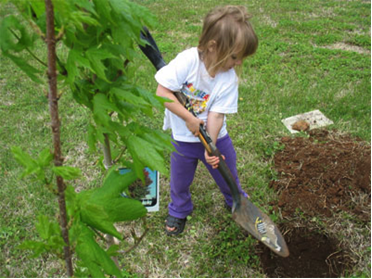 Arbor Day is always the last Friday of April in Indiana and it falls on April 29th this year. Many of us are familiar with the tradition of planting a tree in celebration of this holiday, but have we stopped to count the benefits and reasons why we celebrate planting trees? In honor of Arbor Day, here are 10 reasons to remember why we love and plant trees:
Arbor Day is always the last Friday of April in Indiana and it falls on April 29th this year. Many of us are familiar with the tradition of planting a tree in celebration of this holiday, but have we stopped to count the benefits and reasons why we celebrate planting trees? In honor of Arbor Day, here are 10 reasons to remember why we love and plant trees:
- Public health: Research shows that trees planted in the city make people happier! The result is a reduction in stress levels, crime rates, and improves patient recovery time.
- Beauty: Trees are a great way to soften the often harsh city environment. A tree with vibrant fall color, interesting branch structure or bark patterns in the winter, flowering in the spring, or providing shade with its lush, green leaves in the summer will always provide a pleasing distraction from the urban environment.
- Clean air: Trees are an important source of life-giving oxygen in the air that we breathe. They filter out harmful particulate matter and other pollutants common in the urban or suburban areas that would otherwise make it into our lungs.
- Clean water: Trees help filter the water we drink. The leaves of a tree slow rainfall on the ground, preventing soil erosion and pollutants from washing into our water sources.
- Energy conservation: Trees shade our houses from the sun and provide insulation and create windbreaks, keeping heating and cooling costs during the extreme temperatures of summer and winter lower.
- Property Value: Benefits of trees include lower energy costs and beauty and are recognized and reflected in higher property values where trees are strategically placed.
- Wildlife: Trees provide shelter and food for wildlife that we love to watch, such as songbirds and squirrels.
- Beloved landmarks: City trees properly cared for will provide years of memories for residents. They can serve as a place to gather and as a source of civic pride, as well as a way to mark the changing of the seasons and progression of time.
- Global warming: – Trees are a major factor in carbon sequestration. CO2 is a major contributor to global warming and tress put it to good use rather than causing harm in the atmosphere.
- Our children: Every day, many trees are cut down to allow for our continued growth as populations expand. We must work to replace them if we want our children to receive the same benefits from them in the future that we enjoy today.
We have our 10 reasons, now where will we get our 10 trees? For a $10 contribution you can become a member of the National Arbor Day Foundation and receive a gift of 10 trees through the mail. Also with your membership, you will receive discounts on over 100 other varieties of trees and a free guide to planting and care called The Tree Book.
To become a member, you can join online at the Arbor Day Foundation website.
Resources:
Membership – Arbor Day Foundation
Indiana Arborist Association
Tree Installation: Process and Practices – The Education Store, Purdue Extension Resource Center
Importance of Hardwood Tree Planting – The Education Store
‘Twas The Day Before Arbor Day – Got Nature?
Amy Wetzel, Former Urban Forestry Student
Lindsey Purcell, Urban Forestry Specialist
Purdue University Department of Forestry and Natural Resources
In an effort to provide Indiana bats with more places to live and monitor their population, the Indiana Department of Natural Resources Division of Fish and Wildlife is launching two new projects that property owners can take part of. The first project involves the distribution of 100 bat houses to Hoosier properties that meet certain habitat requirements. Interest in this project has been very positive, and more than enough people have already signed their properties up for the bat houses.
The second project is open to everyone in the state, and its mission is to document the amounts of bats traveling to and from their roosting spots in different areas of the state, whether they are in barns, trees, or in the newly installed bat houses. Participants are asked to count bats for eight to twelve nights between May 17th and July 17th. This data will be helpful to the biologists as it will aid them in knowing where to find bats during summer months. Farmers and foresters may benefit too, since these bats feed on moths of caterpillar species that damage crops and trees.
Check out SFGate’s article “Monitoring, bat house projects aim to help flying mammals” to learn more. For further questions or to get involved with the bat count, please contact Assistant Nongame Biologist Cassie Hudson at chudson@dnr.IN.gov.
Resources:
Monitoring, bat house projects aim to help flying mammals – SFGate
Indiana Bats – Indiana Department of Natural Resources
Nongame & Endangered Wildlife – Indiana Department of Natural Resources
Bat Monitoring Stations – Indiana Department of Natural Resources
Bats – The Education Store, Purdue Extension Resource Center
Cassie Hudson, Assistant Nongame Biologist
Indiana Department of Natural Resources Division of Fish and Wildlife
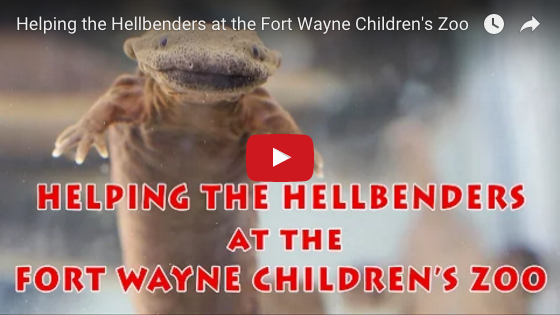 The Fort Wayne Children’s Zoo is one of three Indiana zoos working with Purdue University to study and raise hellbenders in captivity until they are ready to be released into the wild in an effort to grow their native population. Last spring, Rod Williams and his team at the Aquaculture Research Lab transferred young hellbenders to the zoo, where they will be reared for the next couple years. The zoo also puts on an outreach program called Kids4Nature where hellbenders were featured as one of the animals children could vote for with their quarters, collecting money for the hellbenders and other conservation projects.
The Fort Wayne Children’s Zoo is one of three Indiana zoos working with Purdue University to study and raise hellbenders in captivity until they are ready to be released into the wild in an effort to grow their native population. Last spring, Rod Williams and his team at the Aquaculture Research Lab transferred young hellbenders to the zoo, where they will be reared for the next couple years. The zoo also puts on an outreach program called Kids4Nature where hellbenders were featured as one of the animals children could vote for with their quarters, collecting money for the hellbenders and other conservation projects.
In this new video, former Education and Communications Director Cheryl Piropato explains more about the zoo’s outreach process with the hellbenders, and Hellbender Keeper Dave Messmann offers a behind-the-scenes look at the hellbenders themselves. Check out “Helping the Hellbenders at the Fort Wayne Children’s Zoo” to see for yourself and learn more about the Fort Wayne Children’s Zoo’s involvement in the Help the Hellbender initiative.
The other two Indiana zoos are also doing great things to help the hellbenders. Columbian Park Zoo in Lafayette held a “Help the Hellbender Day” last summer with educational games and activities for the whole family to learn more about this at-risk species. Mesker Park Zoo in Evansville is preparing a public hellbender exhibit that will be available later this spring. To stay updated in the world of hellbender outreach, check out HelpTheHellbender.org.
Resources:
Helping the Hellbenders at the Fort Wayne Children’s Zoo – Purdue Extension
HelpTheHellbender.org – Purdue Extension
Help the Hellbender Day at Columbian Park Zoo a Great Success – Got Nature?
Purdue partners with Indiana zoos for hellbender conservation – Purdue Agriculture News
Williams Lab Herpetology and Conservation – Purdue FNR
Rod Williams, Associate Head for Extension and Associate Professor of Wildlife Science
Purdue University Department of Forestry and Natural Resources
You know Spring is around the corner when the days get longer and the temperatures rise. While the weather has pleasantly been warm this year so far, perhaps my favorite harbinger of Spring is the annual arrival of the American Woodcock, also known as the Timberdoodle. Their unique “peents” and the spectacular aerial flights of males looking to attract mates can be very entertaining.
Woodcock are migratory and spend their winters in the southern U.S. They arrive in Indiana in the early spring. This year, they arrived in late-February in the southern part of the state. The Ruffed Grouse Society has a web page with maps of female woodcock and their migration routes for this spring and previous years.
Male woodcock typically set up their singing grounds in open fields and forest openings and recently logged areas. However, they can often be seen in urban areas including parks and even residential communities. Just a couple weeks ago I arrived home just in time to see a male doing his courtship display a block up the road. The best time to observe them is at dusk. They will spend time on the ground “peenting” for a while, then fly high into the air to perform their “dance” only to return to the ground to repeat the process. This will go on until it gets dark. You can sometimes hear them peent in the morning before sunrise. Kyle Daly, a wildlife biologist who has studied them in Minnesota, wrote an excellent article on their spring dance.
Resources
American Woodcock: Habitat Best Management Practices for the Northeast, United States Department of Agriculture (USDA) & Natural Resource Conservation Service (NRCS)
American Woodcock Indiana DNR Fact Sheet, Indiana Department of Natural Resources-Fish & Wildlife
Learn how forests are used by birds new videos, Got Nature? Blog
Winter is a Good Time to Bird?, Got Nature? Blog
Managing Woodlands for Birds, The Education Store-Purdue Extension resource center
Managing Woodlands for Birds Video, Purdue Extension-Forestry and Natural Resources (FNR) YouTube Channel
Climate Change + Birds, Purdue Institute for Sustainable Future
Birds and Residential Window Strikes: Tips for Prevention, The Education Store, Purdue Extension resource center
Breeding Birds and Forest Management: The Hardwood Ecosystem Experiment and the Central Hardwoods Region, The Education Store
No Room at the Inn: Suburban Backyards and Migratory Birds, The Education Store
The Birders’ Dozen, Profile: Baltimore Oriole, Indiana Woodland Steward
Ask An Expert, Playlist, Purdue Extension – FNR YouTube Channel
It’s For the Birds, Indiana Yard and Garden-Purdue Consumer Horticulture
National Audubon Society
The Cornell Lab of Ornithology
Subscribe, Purdue Extension – FNR YouTube Channel
Brian MacGowan, Extension Wildlife Specialist
Purdue University, Department of Forestry and Natural Resources
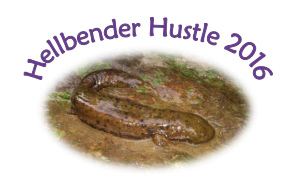 Come to the 13th consecutive Hellbender Hustle 5K Run/Walk at the O’Bannon Woods State Park in Corydon, Indiana to learn more about hellbenders and how they are faring in the nearby Blue River. The race is part road, part trail, and fun for the whole family. After crossing the finish line, enjoy the outstanding refreshments that are a hallmark of this event. Awards will be given to top finishers and there will be a drawing for a handcrafted door prize, made exclusively for the Hellbender Hustle. And if running/walking a 5K isn’t your thing, come and take a look at the Nature Center exhibits or just kick back and relax and listen to the sounds of a local traditional band.
Come to the 13th consecutive Hellbender Hustle 5K Run/Walk at the O’Bannon Woods State Park in Corydon, Indiana to learn more about hellbenders and how they are faring in the nearby Blue River. The race is part road, part trail, and fun for the whole family. After crossing the finish line, enjoy the outstanding refreshments that are a hallmark of this event. Awards will be given to top finishers and there will be a drawing for a handcrafted door prize, made exclusively for the Hellbender Hustle. And if running/walking a 5K isn’t your thing, come and take a look at the Nature Center exhibits or just kick back and relax and listen to the sounds of a local traditional band.
Please check out the Hellbender Hustle 2016 flyer for more information, and print out the registration form to register before the event.
Resources:
Hellbender Hustle 2016 – Event Flyer
Hellbender Hustle 2016 – Registration Form
Help the Hellbender – Purdue Extension
Nick Burgmeier, Research Biologist and Extension Wildlife Specialist
Purdue Department of Forestry and Natural Resources
The National 4-H Wildlife Habitat Education Program (WHEP) is an environmental education program for youth ages 8-19 that teaches all about wildlife habitat and damage management through hands-on activities. This program is the largest of its kind in the nation and has been awarded the Conservation Education Award by The Wildlife Society, the only professional organization that certifies wildlife biologists around the world.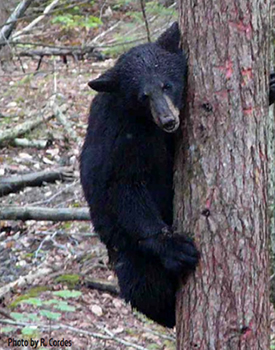
Each year, WHEP has a national contest for its senior level (ages 14-19) youth consisting of three individual events and one team event. The first event, the wildlife challenge, consists of 30 general knowledge questions and 20 animal identifications based on skins and/or skulls. With only 30 minutes allowed for this event, it can be a challenging task.
Competitors can look to the WHEP manual for help studying for the general knowledge questions. The new publication “Wildlife Habitat Evaluation Program: Wildlife Identification Guide” assists further by providing 142 flashcards covering all of the species found on the identification questions, complete with pictures of the animal’s skins and a list of characteristics. Practicing with these flashcards is an extremely effective way to learn the material and perform better in the event.
This year’s contest will be held this summer on July 24th. Study with the “Wildlife Habitat Evaluation Program: Wildlife Identification Guide” publication to get ready!
For more information on WHEP, please check out the Purdue Extension video “WHEP – Wildlife Habitat Education Program” to take a deeper look through the testimonials of students and staff members involved with the program.
Resources:
Wildlife Habitat Evaluation Program Video, What is WHEP?, Purdue Extension-Forestry & Natural Resources (FNR) YouTube Channel playlist
Wildlife Habitat Evaluation Program: Preparing for the Wildlife Challenge – The Education Store, Purdue Extension resource center
Developing a Wildlife Habitat Management Plan – The Education Store
Wildlife Habitat Education Program – Teaching and Learning Wildlife Management Practices – The Education Store
Jarred Brooke, Wildlife Extension Specialist
Department of Forestry and Natural Resources
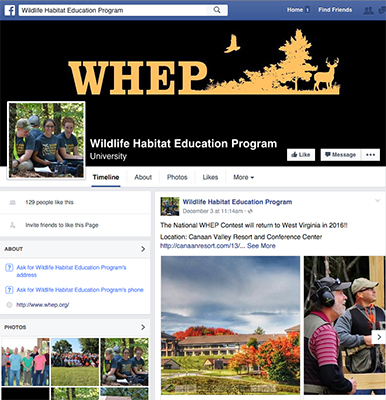 Wildlife Habitat Education Program (WHEP) is a national program of 4-H Youth Development and FFA in which youth learn wildlife identification, wildlife natural history and habitat management, along with testing their knowledge during regional, state, and national Career Development Events. WHEP began in Indiana in 1997 with one 4-H team of four students and has grown to a size of over 33 teams with almost 130 youth participating.
Wildlife Habitat Education Program (WHEP) is a national program of 4-H Youth Development and FFA in which youth learn wildlife identification, wildlife natural history and habitat management, along with testing their knowledge during regional, state, and national Career Development Events. WHEP began in Indiana in 1997 with one 4-H team of four students and has grown to a size of over 33 teams with almost 130 youth participating.
WHEP has recently created a new Facebook page that will announce national and state events, provide information about teaching aids and resources, and offer updates about the latest news in natural resources management throughout the country.
The new publication Wildlife Habitat Evaluation Program: Preparing for the Wildlife Challenge was recently released to help youth practice wildlife identification for the Wildlife Challenge during the WHEP Career Development Event. For more information about WHEP, check out the national website and be sure to like WHEP on Facebook!
Resources:
WHEP Facebook Page
WHEP National Website
Wildlife Habitat Evaluation Program: Preparing for the Wildlife Challenge – The Education Store, Purdue Extension’s resource center
Wildlife Habitat Education Program – Teaching and Learning Wildlife Management Practices – The Education Store
WHEP – Wildlife Habitat Evaluation Program video – Purdue Extension – Forestry and Natural Resources (FNR) YouTube Channel
Jarred Brooke, Wildlife Extension Specialist
Purdue University Department of Natural Resources
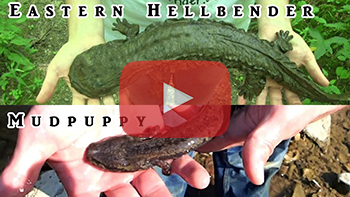 One of the main problems facing eastern hellbender (Cryptobranchus alleganiensis) conservation is that many people mistake this endangered salamander for another common species called a mudpuppy (Necturus maculosus). Conservationists and researchers encourage any outdoor enthusiasts to report eastern hellbender sightings by going to helpthehellbender.org or by reporting to a conservation officer. Unfortunately, many hellbender sightings are actually mudpuppy sightings. This can cause confusion in conservation efforts, so the need for public education on hellbender identification is strong.
One of the main problems facing eastern hellbender (Cryptobranchus alleganiensis) conservation is that many people mistake this endangered salamander for another common species called a mudpuppy (Necturus maculosus). Conservationists and researchers encourage any outdoor enthusiasts to report eastern hellbender sightings by going to helpthehellbender.org or by reporting to a conservation officer. Unfortunately, many hellbender sightings are actually mudpuppy sightings. This can cause confusion in conservation efforts, so the need for public education on hellbender identification is strong.
We have created the “Eastern Hellbender ID Video” to teach people:
- How to identify an eastern hellbender
- How to tell the difference between a hellbender and a mudpuppy
- What to do if they see an eastern hellbender
Help the Hellbender Day at Columbian Park Zoo a Great Success – Got Nature?
Purdue partners with Indiana zoos for hellbender conservation – Purdue Agriculture News
The Nature of Teaching: Discovering the Watershed – The Education Store, Purdue Extension Resource Center
Williams Lab: Herpetology and Conservation – Purdue Department of Forestry and Natural Resources
Purdue Department of Forestry and Natural Resources
Recent Posts
- Magnificent Trees of Indiana Webinar
Posted: May 12, 2023 in Forestry, Forests and Street Trees, Gardening, Got Nature for Kids, Urban Forestry, Webinar, Woodlands - “Fifty Trees of Indiana” Now Has New Name and New Additional Trees
Posted: January 13, 2022 in Forestry, Forests and Street Trees, Got Nature for Kids, How To, Urban Forestry, Woodlands - Multidisciplinary Cicada Outreach Team Honored by PUCESA
Posted: January 7, 2022 in Ask the Expert, Forests and Street Trees, Got Nature for Kids, Urban Forestry, Wildlife - Introduction to Nature of Teaching Sneak Peek Videos
Posted: November 2, 2020 in Aquaculture/Fish, Aquatic/Aquaculture Resources, Gardening, Got Nature for Kids, How To, Land Use, Nature of Teaching, Plants, Ponds, Urban Forestry, Wildlife, Woodlands - Nature of Teaching Program Receives Environmental Education Award
Posted: October 30, 2020 in Aquaculture/Fish, Aquatic/Aquaculture Resources, Disease, Drought, Forestry, Forests and Street Trees, Gardening, Got Nature for Kids, How To, Invasive Animal Species, Invasive Insects, Land Use, Natural Resource Planning, Nature of Teaching, Plants, Ponds, Safety, Wildlife - New Publication – The Nature of Teaching: Disease Ecology
Posted: May 20, 2020 in Disease, Forestry, Got Nature for Kids, How To, Nature of Teaching, Plants, Ponds, Publication, Wildlife - Join us on Facebook LIVE – Hellbender Virtual Tour
Posted: April 20, 2020 in Forestry, Got Nature for Kids, Wildlife, Woodlands - The Nature of Teaching: Adaptations for Aquatic Amphibians
Posted: May 14, 2019 in Alert, Aquaculture/Fish, Aquatic/Aquaculture Resources, Got Nature for Kids, How To, Nature of Teaching, Ponds, Publication, Safety, Wildlife - Can Groundhogs Predict the Weather?
Posted: January 31, 2019 in Forestry, Forests and Street Trees, Got Nature for Kids, Urban Forestry, Wildlife, Woodlands - Publication and Lesson Plans for Food Waste and Natural Resources
Posted: December 12, 2018 in Got Nature for Kids, Natural Resource Planning, Nature of Teaching, Publication
Archives
Categories
- Alert
- Aquaculture/Fish
- Aquatic/Aquaculture Resources
- Ask the Expert
- Christmas Trees
- Community Development
- Disease
- Drought
- Forestry
- Forests and Street Trees
- Gardening
- Got Nature for Kids
- Great Lakes
- How To
- Invasive Animal Species
- Invasive Insects
- Invasive Plant Species
- Land Use
- Natural Resource Planning
- Nature of Teaching
- Plants
- Podcasts
- Ponds
- Publication
- Safety
- Timber Marketing
- Uncategorized
- Urban Forestry
- Webinar
- Wildlife
- Wood Products/Manufacturing
- Woodland Management Moment
- Woodlands
